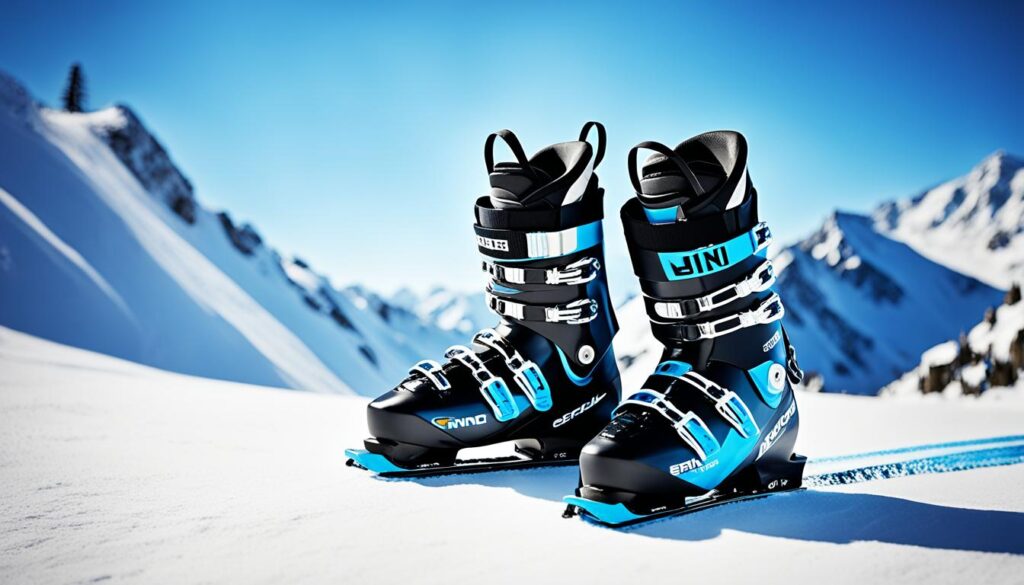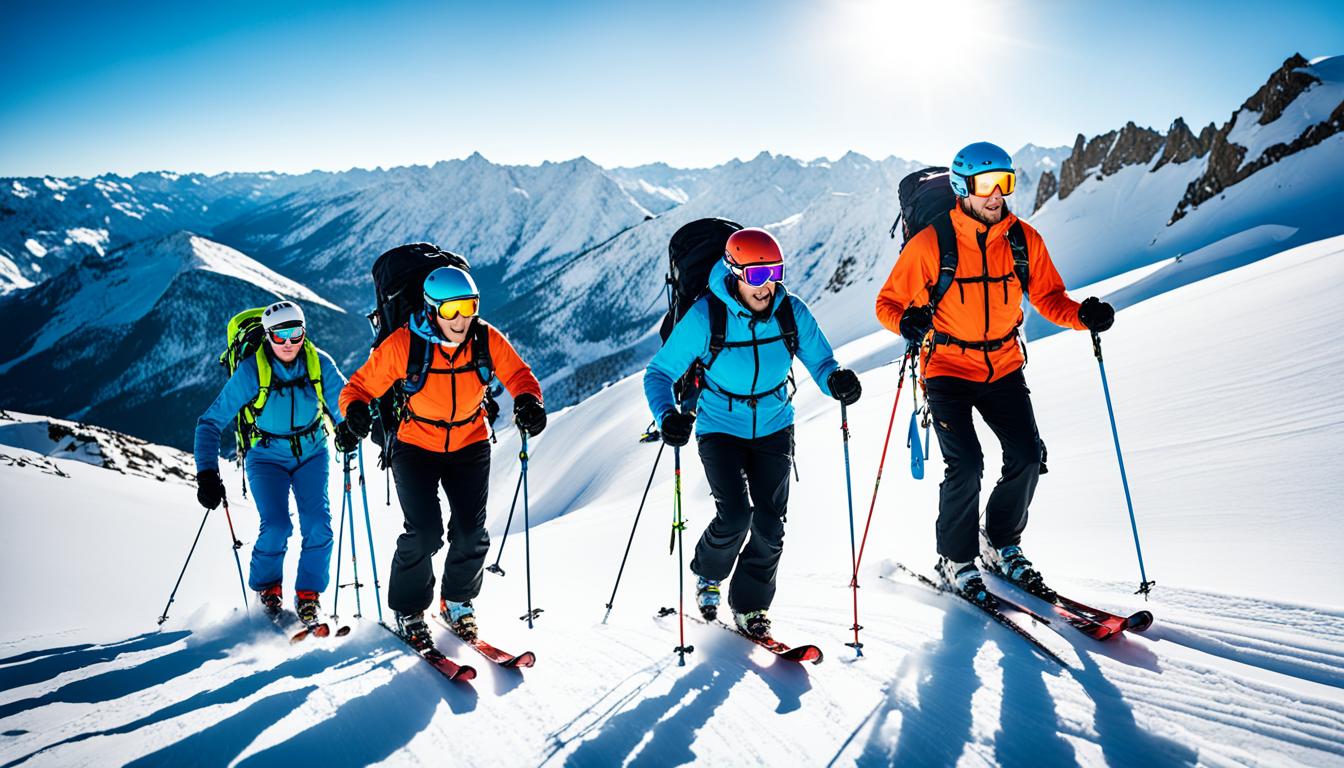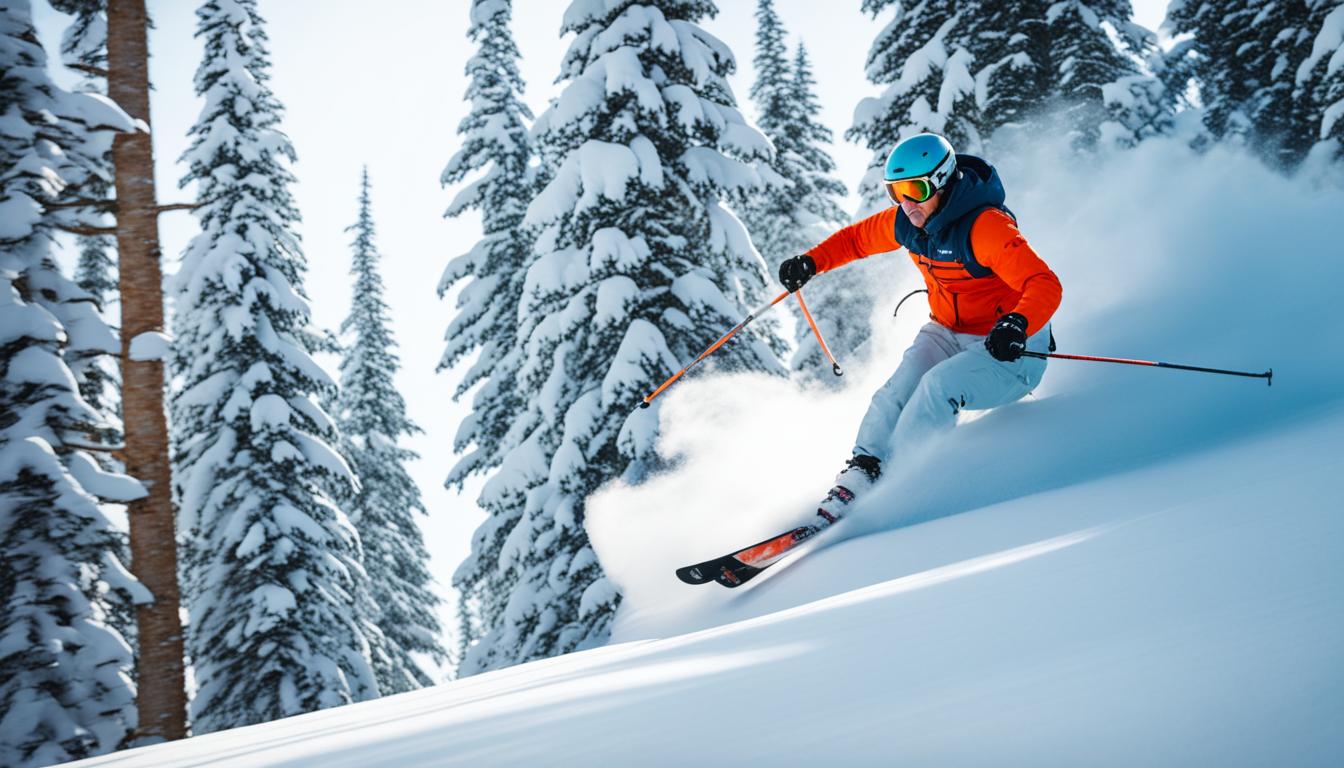Whether you’re a seasoned skier or taking your skills to the next level, having the right equipment is crucial for your safety and enjoyment on the slopes. In this comprehensive guide, we will provide you with valuable insights on the latest ski technology, top-rated gear brands, and essential gear for advanced skiers.
From skis and boots to bindings and protective gear, we will cover everything you need to know to make informed decisions when it comes to selecting the best equipment for your skiing adventures. With our ski gear reviews and expert recommendations, you can stay up to date with the best ski equipment of 2021 and ensure you have the high-performance gear you need for an exceptional skiing experience.
Whether you’re carving down groomed slopes, exploring off-piste terrain, or hitting the moguls, having the right gear can make all the difference. Our ski equipment buying guide will help you understand the different types of skis, boots, and bindings available, allowing you to choose the perfect setup for your skill level and preferred skiing style.
Stay tuned as we dive into the world of advanced ski gear, highlighting the top-rated ski gear brands known for their quality and performance. We will also explore the latest ski technology advancements, so you can stay at the forefront of innovation and take advantage of the cutting-edge features that enhance your skiing experience.
Key Takeaways:
- Choosing the right ski equipment is essential for safety and enjoyment on the slopes.
- Stay informed about the latest ski technology and gear reviews to make confident purchasing decisions.
- Consider your skiing style and terrain to select the appropriate skis, boots, bindings, and protective gear.
- Explore top-rated ski gear brands to ensure high-performance and durability.
- Stay up to date with the best ski equipment of 2021 to optimize your skiing experience.
Choosing the Right Skis
When it comes to skiing, choosing the right skis can make all the difference in your performance and enjoyment on the slopes. Whether you’re navigating groomed terrain, exploring off-trail powder, racing down the mountain, or performing tricks in the snowpark, having the appropriate skis for the job is essential.
Let’s dive into the different types of skis and how to select the perfect pair for your skiing style and terrain.
Groomed Terrain Skis
For those who prefer carving turns on well-maintained slopes, groomed terrain skis are the go-to choice. These skis are designed to excel on packed snow and provide stability, agility, and responsiveness. They offer precise control, making them ideal for high-speed cruising and quick turns. Groomed terrain skis typically have a narrower width and a shorter turning radius, allowing skiers to navigate the slopes with ease.
All-Mountain Skis
If your skiing adventures include a mix of groomed terrain and off-piste conditions, all-mountain skis are the perfect versatile option. With a wider waist width than groomed terrain skis, these skis offer better flotation in soft snow, allowing you to explore ungroomed areas with confidence. All-mountain skis provide stability, maneuverability, and versatility, making them suitable for various snow conditions and terrains.
Freeride Skis
For those seeking adventure beyond the groomed slopes, freeride skis are the ultimate choice. These skis are designed to excel in off-trail conditions, such as deep powder, moguls, and tree runs. With a wider waist width, increased floatation, and enhanced stability, freeride skis allow you to conquer untracked terrain with ease. They offer excellent maneuverability and the ability to handle diverse snow conditions, giving you the freedom to explore the mountain.
Race Skis
If you have a need for speed and enjoy the thrill of downhill racing and slalom courses, race skis are the top performers in these disciplines. These skis are specifically designed for high-speed precision and quick, aggressive turns. They feature a narrow waist width, a long turning radius, and a stiff flex, delivering superior edge grip and responsiveness. Race skis offer stability, control, and lightning-fast acceleration, enabling you to push your limits on the course.
Freestyle Skis
If you’re a park enthusiast who loves hitting jumps, rails, and halfpipes, freestyle skis are made for you. These skis are specifically designed for performing tricks and maneuvers in the snowpark. They have twin tips, allowing for easy switch skiing, and are more forgiving with softer flex patterns. Freestyle skis are highly maneuverable, lightweight, and offer excellent pop for launching off jumps. They provide the flexibility and responsiveness needed for executing tricks and landing with precision.
Ski Design: Rocker, Camber, and Ski Width
When choosing skis, it’s important to consider their design features, such as rocker, camber, ski width, and ski length. Rocker refers to the upward bend of the tip and tail, while camber represents the slight arch in the middle of the ski. Skis with rocker have improved floatation in powder and enhanced maneuverability, making them ideal for off-trail skiing. Skis with camber provide better edge grip and stability on groomed terrain.
Ski width plays a role in the overall performance of skis. Wide skis offer better floatation in deep snow, while narrower skis provide quicker edge-to-edge transitions on groomed slopes. Ski length is determined based on your height, weight, and skiing ability. Longer skis offer stability and speed, while shorter skis provide increased maneuverability and control.
Now that you have a better understanding of the various types of skis and their design features, you can confidently choose the right skis for your preferred terrain and skiing style. Remember to consider factors such as groomed terrain, powder, racing, freestyling, rocker, camber, ski width, and ski length to optimize your skiing experience.
Ski Bindings and Boots
When it comes to advanced skiing, having the right ski bindings and boots is crucial for optimal performance and safety on the slopes. Ski bindings play a vital role in connecting your boots to the skis, ensuring a secure and reliable connection. Additionally, ski boots provide the necessary support and control for navigating challenging terrains. Let’s dive deeper into the world of ski bindings and boots, exploring the benefits of integrated bindings, professional installation, release settings, boot comfort, flex index, sizing, and adjustability.
Integrated Bindings: Convenience and Natural Flex
Integrated bindings are bindings that come pre-installed on specific skis. They offer convenience, as there’s no need for separate installation or compatibility checks. Integrated bindings are designed to flex more naturally with the ski, enhancing responsiveness and maneuverability. This seamless integration between ski and binding allows for precise control and a smoother skiing experience.
Professional Installation: Essential for Safety
Proper installation of ski bindings is crucial for ensuring safe skiing. It is recommended to have your ski bindings professionally installed by an experienced technician. A professional will ensure that the bindings are mounted correctly, aligned with your skiing style, and adjusted to your specific release settings. This expert attention to detail will enhance both your performance and safety on the slopes.
Release Settings: Customization for Advanced Skiers
Release settings are essential for the safety of your knees and lower limbs, as they determine the force required to release the boot from the binding. Advanced skiers who value personalization may prefer to purchase bindings separately. This allows for greater customization of the release settings based on individual preferences and skiing style.
Boot Comfort and Flex Index: Key Factors in Performance
Comfortable ski boots are vital for a pleasant skiing experience. Proper boot fit and comfort ensure that you can focus on your performance without discomfort or pain. When choosing ski boots, consider the flex index, which indicates the boot’s stiffness. Advanced skiers should opt for boots with a higher flex index to handle speed and challenging terrains with enhanced control and responsiveness.
Precise Sizing and Adjustability: The Perfect Fit
Getting the right size ski boots is essential for maximizing both comfort and performance. Ski boots should fit snugly, with no excessive movement or pressure points. The adjustability of ski boots is crucial for achieving the perfect fit. Features such as adjustable buckles, liners, and footbeds allow for fine-tuning and customization to accommodate individual foot shapes and preferences.
By understanding the importance of ski bindings and boots, advanced skiers can make informed decisions to enhance their skiing experience. Whether you opt for integrated bindings or separately purchased bindings, remember to prioritize professional installation and proper adjustment. Invest in comfortable boots with the appropriate flex index and precise sizing for optimal performance. With the right ski bindings and boots, you’ll be ready to conquer any slope with confidence.

Ski Poles, Goggles, and Helmet
When it comes to advanced skiing, having the right equipment is essential for safety and performance on the slopes. Ski poles, goggles, and a helmet are items that should never be overlooked on your ski gear checklist.
Ski Poles
Ski poles provide balance and stability, helping advanced skiers navigate through quick turns and moguls. Choosing the right pole size is crucial for optimal performance. To determine the correct pole size, stand with your ski boots on and hold the poles upside down. Your arms should form a 90-degree angle at the elbow. Remember, poles that are too long can hinder your skiing technique, while poles that are too short may cause imbalance. Look for poles that are lightweight for comfort but strong enough for planted turns.
Goggles
Goggles are an essential piece of protective gear for skiing. They shield your eyes from sun exposure, wind, snow, and debris. It’s crucial to invest in goggles that provide UV protection and have a snug fit to prevent moisture or cold air from entering. When choosing goggles, consider the lens type and tint based on the conditions you’ll be skiing in. Mirrored lenses are ideal for bright sunny days, while yellow or clear lenses are suitable for low-light or snowy conditions.
Helmet
Our safety should always come first. Wearing a helmet while skiing is a must to protect your head from potential injuries. Look for helmets that meet safety standards, such as ASTM F2040 or CE EN 1077. Helmets should fit snugly and comfortably, covering your forehead and the back of your head. Remember, helmet sizing can vary between brands, so it’s essential to try on helmets and choose the one that fits you best.
Ensure that your goggles fit well with your helmet to prevent any gaps that may expose your face to the elements. This also provides a streamlined and comfortable experience.
Here’s a comprehensive ski gear checklist:
| Ski Gear Checklist |
|---|
| Ski Poles |
| Goggles |
| Helmet |
By checking off all the items on this list, you can ensure that you’re well-equipped and ready to hit the slopes with confidence.
Remember, your safety on the slopes should always be a top priority. Investing in high-quality ski gear and adhering to safety practices will enhance your skiing experience and allow you to fully enjoy the thrill of the mountains.
Ski Gear Checklist and Rental Options
To ensure a successful ski trip, it’s important to have all the necessary gear. We’ve put together a comprehensive ski gear checklist to help you pack for your adventure on the slopes. Whether you’re a seasoned skier or a beginner, these items are essential for a safe and enjoyable skiing experience:
- Helmet: Protect your head with a high-quality ski helmet.
- Goggles: Shield your eyes from the sun, wind, and snow with ski goggles.
- Layers: Layer up with moisture-wicking base layers, insulating mid-layers, and a waterproof outer layer.
- Gloves: Keep your hands warm and protected with waterproof ski gloves.
- Ski Boots: Invest in comfortable and properly fitting ski boots for maximum control and performance.
- Skis: Choose skis that match your skiing style and ability level.
- Bindings: Ensure your ski bindings are properly adjusted and compatible with your boots.
- Poles: Use ski poles for balance and stability on the slopes.
If buying all the necessary ski gear is not feasible, renting equipment is a convenient and cost-effective option. One of the best ski gear rental services is Ski Butlers. They offer a wide range of rental packages to suit skiers of all levels, including high-performance skis for advanced skiers.
Ski Butlers goes above and beyond by providing personalized fittings to ensure that the equipment fits you perfectly. They have expert staff who can assist in selecting the right gear for your skiing needs. What makes Ski Butlers truly outstanding is their convenient delivery service. They deliver the rental equipment directly to your location, saving you time and effort.
“Ski Butlers made renting gear hassle-free. The staff was friendly and knowledgeable, and the rental equipment was top-notch. I highly recommend their services!” – Sarah R.
When renting ski gear, it’s important to book in advance, especially during peak seasons. This ensures that you get the equipment you need and allows Ski Butlers to provide the best service possible.
Ski Butlers Rental Packages
Ski Butlers offers a variety of rental packages to cater to different skiing preferences and abilities:
| Rental Package | Features |
|---|---|
| Standard Package | Quality skis, boots, bindings, and poles suitable for beginners and intermediate skiers. |
| Performance Package | High-performance skis and boots for more experienced skiers who want to take their skills to the next level. |
| Junior Package | Specially designed skis, boots, and poles for young skiers. |
By renting from Ski Butlers, you can enjoy the convenience of having top-notch ski gear without the hassle of bringing your own equipment. Their rental packages are flexible and tailored to meet your specific needs.

Whether you choose to buy your own ski gear or rent from Ski Butlers, ensuring that you have the right equipment is crucial for an enjoyable and safe ski trip. Make sure to check off everything on our ski gear checklist and consider rental options for a hassle-free experience on the slopes.
Conclusion
Ensuring you have the right ski equipment and gear is essential for advanced skiers looking to enhance their performance and maximize enjoyment on the slopes. Our Essential Advanced Ski Equipment and Gear Guide has provided valuable insights into choosing skis, bindings, boots, poles, and protective gear, as well as the option of ski gear rental.
By following this comprehensive guide and equipping yourself with all the necessary equipment and gear, you can embark on a successful and memorable ski trip. Whether you decide to invest in your own gear or take advantage of ski gear rental options, having the proper equipment is crucial for maximizing your skiing experience.
Remember to pack all the ski essentials mentioned in our guide, such as high-quality skis, sturdy bindings, comfortable boots, reliable poles, and protective gear. Having the right equipment not only ensures your safety but also contributes to an enjoyable and hassle-free skiing adventure.
For those who prefer the convenience of ski gear rental, reputable services like Ski Butlers offer a range of rental packages, including high-performance skis, with the added convenience of personalized fittings and delivery right to your location. This eliminates the stress of transporting your gear and allows you to focus on enjoying your ski trip.
FAQ
What should I consider when choosing skis?
When choosing skis, consider the type of terrain you’ll be skiing on and select skis that are suitable for that terrain. Factors such as rocker, camber, ski width, and ski length should also be taken into account to optimize performance on different snow conditions.
Are integrated bindings better than separate bindings?
Integrated bindings, which come pre-installed on specific skis, are convenient and flex more naturally. However, advanced skiers may prefer to purchase bindings separately for greater customization.
What should I consider when choosing ski boots?
When choosing ski boots, consider the flex index, which indicates the boot’s stiffness. Advanced skiers should opt for stiffer boots designed for speed and more challenging terrains. Sizing and adjustability are also important factors to consider for a precise and comfortable fit.
What size ski poles should I choose?
Choose ski pole size based on your height, with a 90-degree angle at the elbow. Poles should be strong enough for planted turns but lightweight for comfort.
Why are goggles and a helmet important for skiing?
Goggles protect your eyes from sun exposure and debris, while a helmet provides essential head protection. Goggles should fit snugly with your helmet to ensure optimal safety and comfort.
What should be included in a ski gear checklist?
A comprehensive ski gear checklist should include items such as a helmet, goggles, layers, gloves, ski boots, skis, bindings, and poles.
What are the options for renting ski gear?
If buying all the equipment is not feasible, renting gear is a convenient option. Ski Butlers, a renowned rental service, offers a variety of rental packages for skiers of all levels, including high-performance skis. They provide personalized fittings and deliver the equipment to your location, making the rental process hassle-free.




